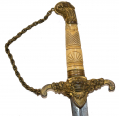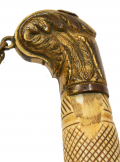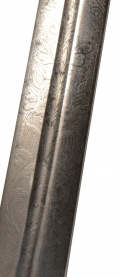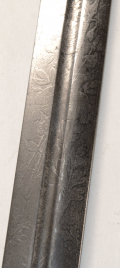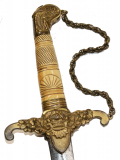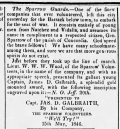site search
online catalog
MEXICAN WAR PRESENTATION SWORD OF CAPTAIN JAMES DILL GALBRAITH, OF NATCHEZ, MISSISSIPPI, BY THE SPARROW VOLUNTEERS: CO. E, 4th REGIMENT, PERSIFOR F. SMITH’S BRIGADE OF LOUISIANA VOLUNTEERS, MAY 1846

$3,000.00 SOLD
Quantity Available: None
Item Code: 870-205
Presentation of this sword on May 15, 1846, at New Orleans, just before the company, with Galbraith in command, left for the Rio Grande, is reported in the May 20, 1846, edition of the Mississippi Free Trader. The report is expanded in the May 26 edition of the Mississippi Free Trader And Natchez Gazette not only to include a few details of the presentation, but to quote the very inscription on the sword as it exists today.
The sword has an etched 30-inch blade, straight, double-edged with spearpoint, oval in cross section, with a central fuller for part of its length. The hilt and scabbard are gilt brass, each with perhaps 20 percent of the gilt and the remainder with an undisturbed darker age patina. The pommel is surprising- a bird’s head in form that might be mistaken for an eagle head at a distance since there is a smooth neck and central crest, but with sides cast and chased with curving floral motifs and feather-like leaves draping down from the top on either side. The tang is capped with a seven-armed cross or geometric rosette. A chain knuckleguard links the pommel to one of the down-turned quillons that are flat in cross-section at the end, with disk finials, but closer to the quillon block are deeply cast and chased with dense floral motifs- acanthus leaves, leafy scrolls and berries, and what looks almost like a crown at lower center, but may be a basket, with a fan spreading out beneath onto the shield shaped langet on either side. The grip is bone, decorated with checkering, three grooves, a fan, etc., and a gilt brass ferrule at the guard. The grip has a mellow cream tone, a couple of short hairlines, and one longer chip from under the pommel that reaches the upper part of the checkering on the obverse.
The blade is etched on both sides with the panel extending a few inches beyond the fuller and ending in an arabesque arch. The edge and point are good. The metal is smooth and turning toward steel gray, but with the motifs very visible against the graying frosting. Both sides use floral elements entwining martial motifs. On one side floral scrolls transform into leafy branches to surround a halberd, spear, and what may be kettle drums. On the other a long, leafy vine extends up to envelop a trophy of arms consisting of a crossed sword, spear and shield. At the top of the fuller what seems clearly a palm or palmetto tree sprouts up, with an urn and long flowering plant above finishing off the panel.
The obverse scabbard continues the dense floral decoration of the hilt and blade with geometric and floral motifs engraved from the flat throat, above and below the upper ring band, which supports two carrying rings and a floral cast frog stud. A symmetrical floral spray with a diamond center is engraved midway to the lower band, which supports one ring and has geometric and floral motifs on eithe side, matching the upper ring band, and the same motifs decorate the lower portion of the scabbard at the drag.
The reverse of the scabbard is plain, and shows more wear to the gilt than the obverse, natural from being worn against the body. Between the upper ring mounts, however, is a very clear and very professionally done script inscription reading:
“Presented to / Capt. J. D. Galbraith / by his Company / The Sparrow Volunteers / We’ll Try!/ 15th May 1846.”
By 1841 Galbraith, possibly the son of Robert D. and Mary J. Galbraith, was Deputy County Clerk of Adams County, Mississippi, with its seat at Natchez. He was thus fairly prominent in the community, confirmed by the fact that in February 1846 he was chosen as one of the trustees assigned to take over the Planter’s Bank, which had apparently failed. At the outbreak of hostilities between the U.S. and Mexico along the Rio Grande in April 1846 Mississippi volunteers, mostly from Natchez at this early point, began organizing in response to a call from Gen. E.P. Gaines, head of the U.S. Army’s Western Department for two regiments from the state. His later election as captain indicates Galbraith played leading part in recruiting one of these groups. Unfortunately, Gen. Gaines was not authorized to call upon Mississippi for troops, leaving those anxious to go with little choice but to cross the Mississippi River and join Louisiana units.
Concordia Parish, Louisiana, was just opposite Natchez and the company gained recruits from Vidalia, its seat, officially organizing there on May 11, 1846, under the supervision of Brigadier General Sparrow, commander of the 10th Brigade, Louisiana Militia, adopting the name “The Sparrow Volunteers” in his honor, and electing Galbraith captain. The company was referred to as well uniformed before leaving Vidalia and the recipients of a “handsome flag” on behalf of the “patriotic ladies of Vidalia.”
They departed the next day on the steamer North Alabama for New Orleans, where they were formally mustered in, 57 officers and men, as Company E of the 4th Regiment of Louisiana Militia, nicknamed the Montezuma Regiment, under Col. Horation Davis, on May 14 and May 15, by future Confederate General P.G.T. Beauregard. The regiment was part of a brigade of six Louisiana regiments commanded by Persifor F. Smith enlisted for six month’s service. Given the date of the presentation on the sword it was likely acquired in somewhat hurried fashion in New Orleans, though election of Galbraith as captain and even choice of the company name were likely informally decided before things became official on May 11.
The May 20 Natchez newspaper account indicates the presentation took place on Saturday May 16. The May 26 report apparently repeats a New Orleans account published on May 20, saying, “Lieut. W.W.W. Wood, of the Sparrow Volunteers, in the name of the company, and with an appropriate speech, presented it gallant young Captain, James D. Galbraith, a splendid gold mounted sword, with the following inscription engraved upon it: Presented to / Capt. Jas. D. Galbraith / by his Company / The Sparrow Volunteers / ‘We’ll Try!’/ 15th May 1846.” Only the abbreviation “Jas.” for James differs from the actual inscription- a very small point.
The company left New Orleans on May 19 for barracks below the city in preparation for sailing (apparently the next day,) landed on Brazos Santiago Island, and on June 7 crossed the Rio Grande, joining the army at Matamoros. From there they were posted to a small town reported to be sixteen miles from Matamoros, likely along the river. A letter by Galbraith published in a newspaper indicates that in early July they were expecting to rejoin the army at Matamoros for Taylor’s advance on Monterrey by July 15. Unfortunately for their prospects of seeing action as a unit, the U.S. government decided they could not be retained for a term longer than three months. A few of the company were discharged at the end of July to reenlist in other units, but the rest were discharged in August, returning to New Orleans, and reaching Concordia Parish again on August 19. They had suffered at least one death in the company, and returned looking somewhat worse, or fiercer, for the wear. The Concordia Intelligencer joked that they were bearded and only recognizable to their friends by their eyes, good looking men formerly, but now “ugly enough” to “make a whole army of devils take to their heels at first glance….”
Galbraith later applied unsuccessfully for bounty lands for his service, but saw opportunity in the California Gold Rush and headed west, arriving in San Francisco on Aug. 3, 1849, after a rather long 77-day voyage from Panama on the English barque Circassian. By 1853 he was living in San Francisco and owned half of a thousand-acre tract of land in Sonoma. He returned to Natchez to visit family, likely his sister and her children (and perhaps his mother, whose date of death is uncertain,) but did not live to go back to California, dying at Natchez in December 1853 and being interred in the Washington Cemetery in Adams County.
This is an interesting Mexican War sword with great presentation that reflects the war fever gripping much of the south as tensions along the contested border with Mexico finally broke out into open conflict. [sr] [ph:L]
~~~~~~~~~~~~~~~~~~~~~~~~~~~~~~~~~~~
THIS ITEM, AS WITH ALL OTHER ITEMS AVAILABLE ON OUR WEB SITE,
MAY BE PURCHASED THROUGH OUR LAYAWAY PROGRAM.
CLICK HERE FOR OUR POLICIES AND TERMS.
THANK YOU!
Inquire About MEXICAN WAR PRESENTATION SWORD OF CAPTAIN JAMES DILL GALBRAITH, OF NATCHEZ, MISSISSIPPI, BY THE SPARROW VOLUNTEERS: CO. E, 4th REGIMENT, PERSIFOR F. SMITH’S BRIGADE OF LOUISIANA VOLUNTEERS, MAY 1846
For inquiries, please email us at [email protected]
Most Popular
Historical Firearms Stolen From The National Civil War Museum In Harrisburg, Pa »
Theft From Gravesite Of Gen. John Reynolds »
Selection Of Unframed Prints By Don Troiani »
Fine Condition Brass Infantry Bugle Insignia »
British Imported, Confederate Used Bayonet »
Scarce New Model 1865 Sharps Still In Percussion Near Factory New »
featured item
THEFT FROM GRAVESITE OF GEN. JOHN REYNOLDS
A large artillery shell, one of pair that sit on either side of the grave of Gen. John F. Reynolds in Lancaster Cemetery, Lancaster, PA has been removed from the site. If anyone comes into contact with the shell or has any information regarding its… . Learn More »
site search
Upcoming Events
May 16 - 18: N-SSA Spring Nationals, Fort Shenandoah, Winchester, VA Learn More »




